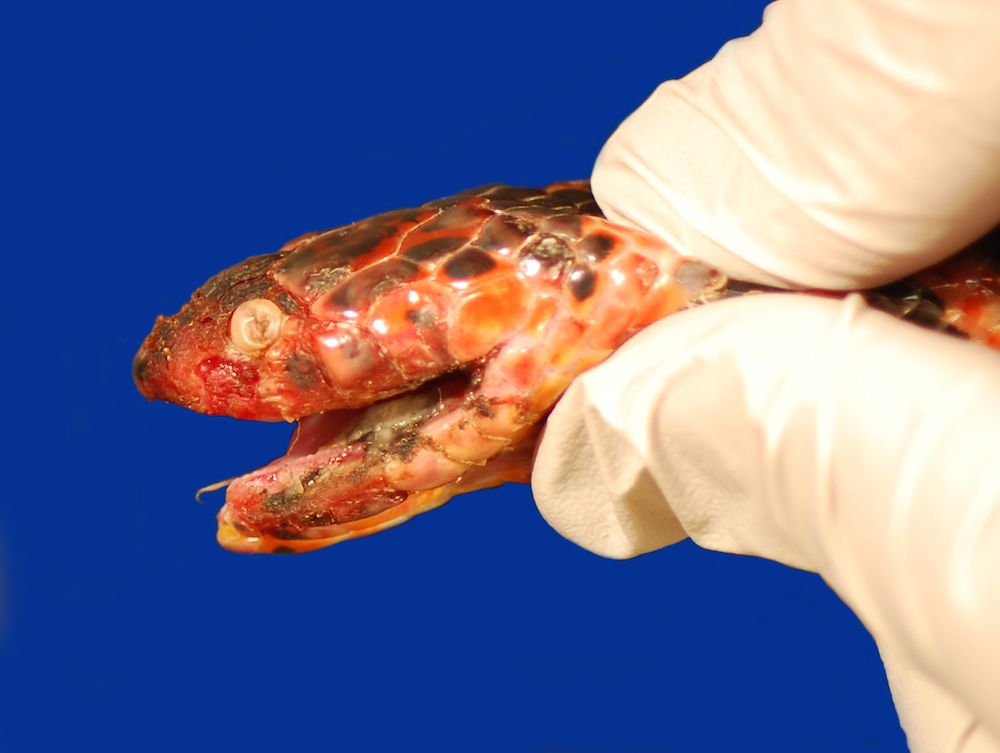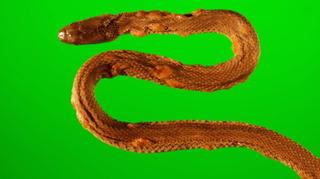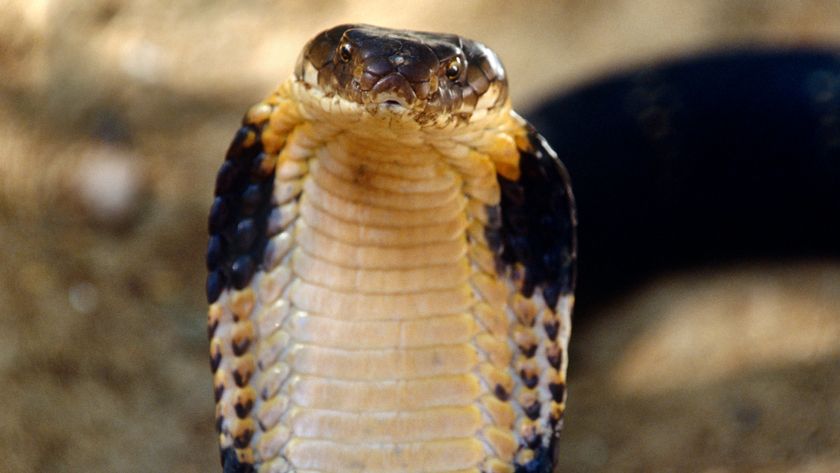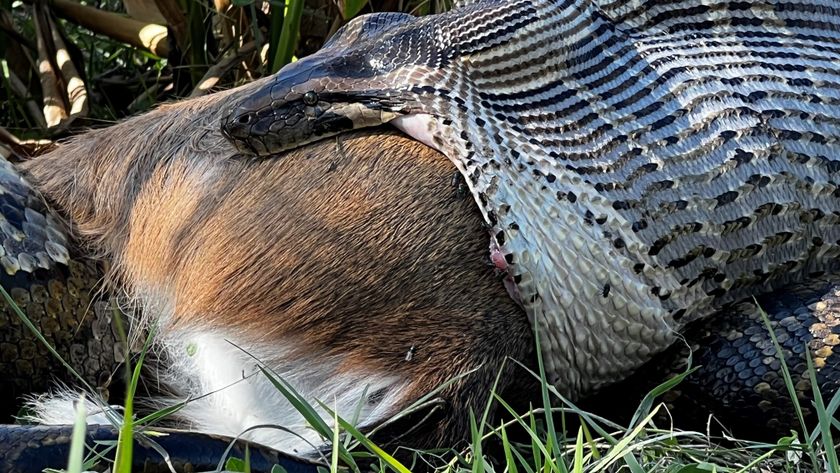Mysterious Fungal Disease Proves Deadly in Wild Snakes

The female mud snake found May 28 in Georgia had cloudy eyes and patches of white, thickened scales. A strange, dark-gray material covered the inside of her mouth, and the skin on the front of her face had peeled away, leaving behind an angry red mess.
In fact, the deadly fungus that caused this snake's injuries is killing snakes across the Midwest and Eastern United States, said Matthew Allender, a clinical assistant professor of zoo and wildlife medicine at the University of Illinois at Urbana-Champaign.
Little is known about the condition, which is called snake fungal disease, but researchers are now investigating how snakes catch it, fight it and can eventually die from it. [See images of snake fungal disease]
Within the next year, researchers may know more about antifungal medications, as well as what temperatures might impede the fungi's growth, Allender said.
Snake fungal disease is thought to be caused by the fungus Ophidiomyces ophiodiicola. It only affects snakes, but some researchers have compared it with another lethal fungal disease, white nose syndrome, which is killing bats in the United States, Allender said.
Researchers first saw the snake fungal disease in a captive black rat snake in Sparta, Georgia, in 2006. Since then, snake fungal disease has been reported in snakes in nine states, including Illinois, Florida, Massachusetts, Minnesota, New Jersey, New York, Ohio, Tennessee and Wisconsin, according to the U.S. Geological Survey's National Wildlife Health Center.
The disease is likely more widespread than what has been seen so far, and may be in the western United States as well. "My guess is, the states we haven't found it in, it's because we haven't been looking," Allender said.
Sign up for the Live Science daily newsletter now
Get the world’s most fascinating discoveries delivered straight to your inbox.
At first, researchers found infections only in rattlesnakes and other vipers, "which is not good because those snakes tend to be the most endangered already," Allender said. But now the disease has also surfaced in nonvenomous snakes, including snakes that are both solitary and social, which suggests the animals can catch the disease from each other as well as from fungus in the soil.
"The infection can start from multiple different routes," Allender said. "They just have to have contact with the fungus."
Researchers have now confirmed the fungal infection in more than 14 species of snakes, including northern water snakes (Nerodia sipedon), eastern racers (Coluber constrictor), rat snakes (Pantherophis obsoletus species complex), timber rattlesnakes (Crotalus horridus), massasaugas (Sistrurus catenatus), pygmy rattlesnakes (Sistrurus miliarius) and milk snakes (Lampropeltis triangulum), the National Wildlife Health Center reported.
Like the Georgian mud snake, which was euthanized, snakes with the fungal disease often have scabs or crusty scales. The outermost layer of their skin may separate from the underlying skin, even when the snake is not molting. They may also show cloudy white eyes and swollen faces. [7 Shocking Snake Stories]

Some snakes don't show disfigurement. For example, some garter snakes and water snakes only show signs of pneumonia. "When you open them up, you can see the fungus in the lungs," Allender said.
It's unclear how widespread the fungus is, or how many snakes it kills yearly. In one report of 24 cases in massasauga snakes, only one of them survived, he said. What's more, there are only between 100 and 150 massasaugas left in Illinois, and about 15 percent are infected with the fungus, he added.
A 2011 study, published in the journal Biological Conservation, linked the fungus with a 50 percent drop in the timber rattlesnake population in New Hampshire between 2006 and 2007.
"It's frustrating because we don't have a lot of the information that we want," Allender said.
He and his colleagues are looking for clues about the disease's origins. They examined 261 museum snake specimens dating back to 1873. "From 1873 through 1999, there wasn't a single case," Allender said. But in samples dating to 2000 and later, the researchers began to find evidence of the fungus.
The team is also working on a test to identify the fungus at its early stages, which may help the team members treat infected snakes, he said. The researchers presented their data in October at the American Association of Zoo Veterinarians conference in Orlando, Florida.
As the fungus continues to kill snakes, ecosystems are likely to take a hit, said John Jensen, a senior wildlife biologist and herpetologist with the Georgia Department of Natural Resources.
"People think that they just eat rats and mice," Jensen said, but snakes also eat fish and frogs. "And obviously there's other animals that depend on snakes for prey."
Many snakes are losing their habitat to urbanization. Venomous snakes often reproduce every other year or every third year, making it hard for them to replenish their numbers, especially as more snakes get hit by cars or catch diseases.
"All of those things knock away at the sustainability of a population," Allender said. "Not any one thing would cause it, but when you add it together and you add the catastrophe of an infectious disease, that’s when you start to get the possibility of an extinction event."
Follow Laura Geggel on Twitter @LauraGeggel and Google+. Follow Live Science @livescience, Facebook & Google+. Original article on Live Science.

Laura is the archaeology and Life's Little Mysteries editor at Live Science. She also reports on general science, including paleontology. Her work has appeared in The New York Times, Scholastic, Popular Science and Spectrum, a site on autism research. She has won multiple awards from the Society of Professional Journalists and the Washington Newspaper Publishers Association for her reporting at a weekly newspaper near Seattle. Laura holds a bachelor's degree in English literature and psychology from Washington University in St. Louis and a master's degree in science writing from NYU.
Most Popular




